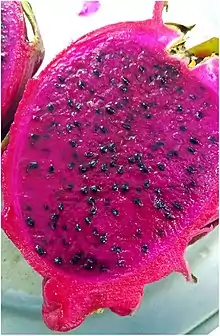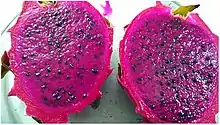Hylocereus costaricensis
Hylocereus costaricensis, the Costa Rican pitahaya or Costa Rica nightblooming cactus, is a cactus species native to Costa Rica and Nicaragua.[1] The species is grown commercially for its pitahaya fruit, but is also an impressive ornamental vine with huge flowers. Most plants grown under the name Hylocereus polyrhizus refer to this species. The latter name is ambiguous and not used.
| Red-fleshed pitahaya | |
|---|---|
 | |
| Scientific classification | |
| Kingdom: | Plantae |
| Clade: | Tracheophytes |
| Clade: | Angiosperms |
| Clade: | Eudicots |
| Order: | Caryophyllales |
| Family: | Cactaceae |
| Subfamily: | Cactoideae |
| Genus: | Hylocereus |
| Species: | H. costaricensis |
| Binomial name | |
| Hylocereus costaricensis (F.A.C.Weber) Britton & Rose | |
| Synonyms | |
| |
Etymology
Named after Costa Rica where it was first discovered.
Origin and habitat
The species is native to Costa Rica and Nicaragua, although its natural range is hard to determine because it has been cultivated so widely. It occurs in dry or deciduous coastal forests, at elevations of 0–1,400 m (0–4,593 ft) above sea level.[1]
Systematics
Hylocereus costaricensis is closely related to Hylocereus ocamponis, but lacks the horny stems margins of the latter species.
Description
- Stem scandent, 1-3 (-10) cm wide, usually very thick; ribs 3 (-4), margins straight to shallowly scallop-lobed; internodes 2-3.5 x 0.1-0.2 cm; often folded, areoles on prominences, bearing dense, short wool and (1-) 3-6 (-9) short, dark spines 2–4 mm, hairs 2, often bristle-like, soon dropping; epidermis grayish green, +- glaucous in fresh material.
- Flowers funnel-shaped, 22–30 cm long, strongly perfumed, young buds globular; cylindric-ovoid, ca 4 cm long, bracteoles narrow, foliaceous, numerous, imbricate, 1–2 cm long; receptacle stout, 10–15 cm, throat obconic, 6 cm in wide at the orifice, bracteoles foliaceous, persistent, particularly imbricating towards the base, green with purple margins; tepals 11–15 cm, the outer greenish yellow, the inner white; stigma lobes ca. 12, not forked; ovary covered with large, broadly to narrowly triangular, overlapping bracteoles, 0.5–3 cm.
- Fruit broadly ovate to globose, bright magenta, pupla purple; seeds pear-shaped, black, ca 10mm.



Cultivation
An easily cultivated, fast growing epiphyte or xerophyte. Needs a compost containing plenty of humus and sufficient moisture in summer. It should not be kept under 10 °C (50 °F) in winter. Can be grown in semi-shade or full sun. Extra light in the early spring will stimulate budding. Flowers in summer or autumn.
Nutrition
This fruit is one of the few to have indicaxanthin, a betalain, a type of plant pigment antioxidant.
Eating this fruit may cause alarm as it may cause feces and urine to appear red.
See also
| Wikispecies has information related to Hylocereus costaricensis. |
References
- Hammel, B. (2013). "Hylocereus costaricensis". IUCN Red List of Threatened Species. 2013: e.T151841A567360. doi:10.2305/IUCN.UK.2013-1.RLTS.T151841A567360.en.
